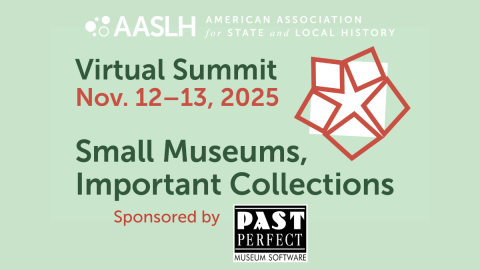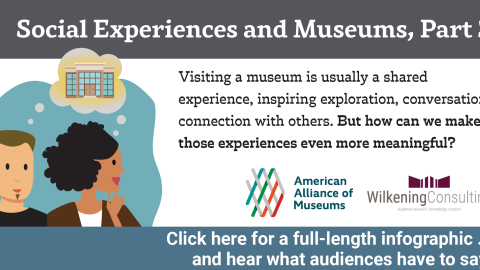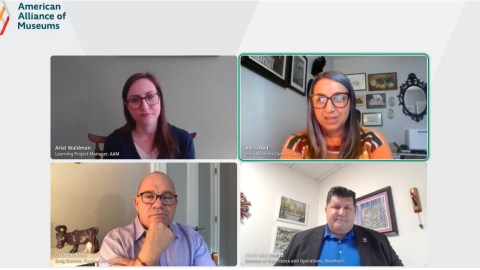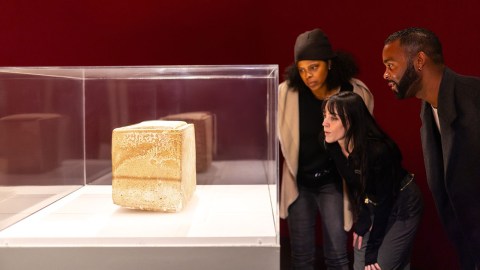
This visual Data Story is based on findings from the 2025 Annual Survey of Museum-Goers, a national survey of American museum visitors from AAM and Wilkening Consulting. Every year, the survey partners with individual museums to research their audiences and yield insights about their behaviors and preferences, both on an institutional and national level. (Learn more about the purpose and methodology of the survey here.) Interested in joining the 2026 edition on the themes of earned income and the meaning and value of museum experiences? Sign up by December 1 to unlock a special early bird rate!

For most people, visiting a museum is an inherently social experience. That is, if we were to stand on the floor of a typical museum on a typical day, we would see groups of families and friends…and perhaps a few solo visitors.
The data bears this out. In the 2025 Annual Survey of Museum-Goers, we asked both frequent museum-goers as well as casual and sporadic museum-goers about their visitation patterns:
Which of the following best describes how you visit museums?
| Frequent (Respondent source via museum communications lists) | Casual (At least one museum visit in past year–respondent source via broader population sample of U.S. adults) | Sporadic (Visits museums occasionally, but not in past year–respondent source via broader population sample of U.S. adults) | |
|---|---|---|---|
| I only visit museums with family and friends | 31% | 43% | 45% |
| I mostly visit with others, but occasionally on my own | 30% | 26% | 22% |
| I sometimes visit with others, and sometimes on my own | 22% | 19% | 18% |
| I mostly visit on my own, but occasionally with others | 14% | 8% | 8% |
| I strongly prefer to visit on my own | 2% | 4% | 7% |
Frequent museum-goers are those who responded to a museum’s request to take a survey (and visit museums at the most frequent rate). Casual and sporadic museum-goers were sourced from our demographically representative sample of U.S. adults, and said they visit museums at least “every few years” (that is, not “never”). A whopping 79% of U.S. adults fell in this category!
In some ways, the results from the three groups are not that dissimilar in that most museum-goers, regardless of frequency, are visiting with others. And similar numbers, about 15%, are more likely to visit solo.
But there is a bit of nuance here.
Overall, casual and sporadic museum-goers are significantly more likely to say they only visit museums with family and friends. Compared to frequent museum-goers, they are more likely to put a self-imposed condition on museum visits—they have to find someone to go with.
What’s interesting about this group of casual and sporadic museum-goers is that they are more likely to say things like “I’d go to museums, but none of my family or friends are interested.” Perhaps there is a disconnect happening, where potential visitors might be interpreting the absence of conversation about museums as a lack of interest. In other words, museums might just be “off their radar,” not off their list. And considering that only 21% of U.S. adults say they “never visit museums,” there’s likely an opportunity to spark that first conversation.
There are differences by life stage and frequency as well.
Among frequent museum-goers, parents and guardians of minor children were over 2x more likely to say they only visit with family and friends. And this makes sense: they are probably visiting with their minor children.
But among casual and sporadic museum-goers, this wasn’t the case at all. Instead, adults over 60 were by far the most likely to say they only visit with family and friends, 54%. Older adults from the broader population are already the least likely to visit museums by life stage, so museums striving to engage this under-served audience should consider focusing on the social experience, whether with multi-generational family visits or among peer groups.
We wanted to know more about what made museums good for social connection, so we asked an additional question to those respondents who said they visit museums “only,” “mostly,” or “sometimes” with others.
When you visit museums with family or friends, what kinds of activities or amenities would help you connect or interact with each other? (Choose those that are most important to you.)
| Frequent | Casual | Sporadic | |
|---|---|---|---|
| Simply exploring exhibitions and/or galleries | 75% | 64% | 54% |
| Places to eat/have a beverage and talk | 61% | 46% | 43% |
| Outdoor spaces to relax and/or decompress | 51% | 46% | 35% |
| Places to sit and chat | 47% | 44% | 39% |
| Scheduled events like movies, concerts, lectures, classes, etc. | 45% | 37% | 26% |
| Taking photos to remember the experience | 39% | 55% | 46% |
| Places to create together (such as arts, crafts, STEM activities) | 31% | 33% | 24% |
| Games or challenges for us to play together | 24% | 28% | 26% |
| Prompts with interesting questions for us to ask each other | 22% | 34% | 22% |
| None of these | 1% | 1% | 2% |
By far the most popular response was exploring exhibitions. That is, visitors want to experience some sort of stimulus that catalyzes a shared experience.
And then they want places that are conducive to conversation, ideally with food options or outdoors (or even better, both!).
Sound familiar? It should, because this fits in exactly with what museum-goers shared when they talked about their favorite places for social connection more generally (as we discussed in the second Data Story of this series).
“I enjoy going to events, exhibits, activities that challenge me and my friends. I enjoy discussing and engaging during and afterward. Barriers would be lack of sufficient private/quiet space to talk and accessibility (price, parking, hours). It’s nice to have an outdoor sitting area with coffee or food to talk. Intimate homey spaces are nice.”
Examining this data by life stage uncovers a few significant differences as well.
Younger adults, regardless of parental status, are more likely to want places to create together and/or games or challenges to play together.
In fact, “more” is a bit of an understatement.
Let’s look at these two responses in detail, cut by frequent museum-goers by life stage:
| Life stage | Places to create together (such as arts, crafts, STEM activities) | Games or challenges for us to play together |
|---|---|---|
| Under 40, no children | 41% | 37% |
| Parent or guardian | 58% | 46% |
| 40–59, no children | 28% | 24% |
| 60 or older, no children | 19% | 13% |
Clearly, younger adults are much more likely to be looking for interactive experiences in museums than older adults—a pattern we’ve seen for years.
Something else stood out as well, this time about the casual and sporadic museum-goers from the demographically representative sample of U.S. adults. About half wanted to take photos to remember the experience, making it the second most popular answer choice among these respondents (and significantly higher than frequent museum-goers).
Let’s consider why. If you go to museums frequently, it isn’t a particularly unusual experience. Many frequent museum-goers can visit museums without even thinking about taking a photo to memorialize the experience. Maybe they will, maybe they won’t (or they may take a photo for a research-related reason, but that’s different).
In contrast, casual and sporadic museum-goers include a lot of people who rarely find themselves in museums. That makes visiting a museum a more out-of-the-ordinary experience…and one they are much more likely to want to remember with the photos they take.
You probably already know where people naturally want to take photos at your museum. Thinking through how to better support them logistically is a win-win in that it smooths out that visitor experience for them and for other visitors who might otherwise be inconvenienced by a photo logjam.
Overall, our data strongly supports that museums are considered by frequent museum-goers as key partners for supporting their social connections, whether with friends and family.
“Museums offer a shared experience, sparking conversations and new perspectives that can strengthen relationships. Walking through exhibits together, discussing art or history, and simply enjoying a quiet, engaging space can create meaningful memories.”
It also indicates that museums could serve this role more broadly if more people were thinking of them in this way…but that there is a bit of a perception gap for less frequent visitors. This potential audience is looking for social connection in a variety of places and activities, as our first Data Story in this series shared. Museums can be a more obvious choice for them as well.
In our next Data Story, we’ll explore some of the barriers people experience when finding time to spend with those they care about…and why they think museums are worth the effort.
Annual Survey of Museum-Goers Data Stories are created by Wilkening Consulting on behalf of the American Alliance of Museums. Sources include:
- 2025 Annual Survey of Museum-Goers, n = 98,904; 202 museums participating
- 2025 Broader Population Sampling, n = 2,079
- 2017 – 2024 Annual Surveys of Museum-Goers
Data Stories share research about both frequent museum-goers (typically visit multiple museums each year) and the broader population (including casual, sporadic, and non-visitors to museums). See the Purpose and Methodology (Update) Data Story from September 11, 2025 for more information on methodology.
More Data Stories can be found at https://wilkeningconsulting.com/data-stories/.
© 2025 Wilkening Consulting, LLC








